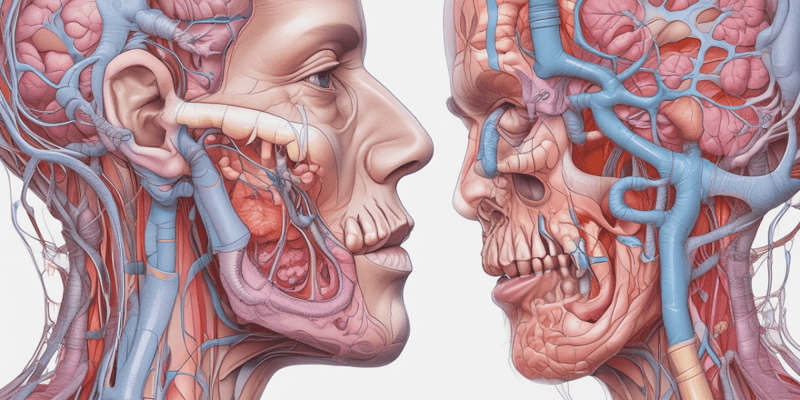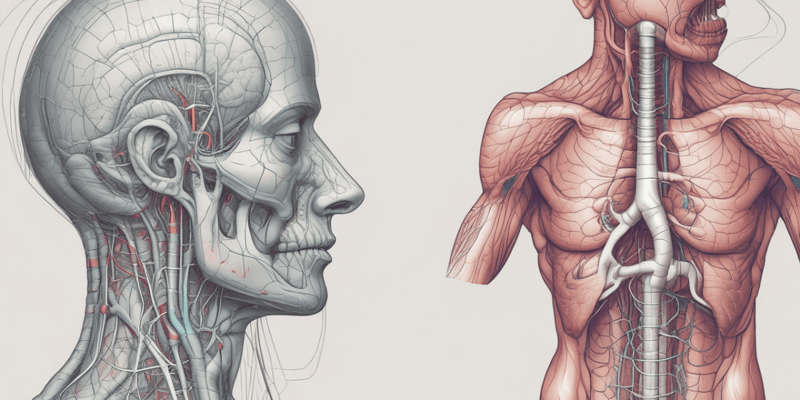18 Questions
What is the primary function of the hyoid apparatus?
To aid in tongue movement and swallowing
What is the purpose of the cilia in the respiratory system?
To pass mucus containing dust, debris, and cells out of the lungs
Where does the trachea divide into the two main bronchi?
At the carina
What type of mucosa lines the respiratory system?
Respiratory mucosa
What is the result of the cilia passing mucus out of the lungs?
The mucus is swallowed and digested
What is the term for the indentation in an organ where blood vessels, ducts, etc. enter or leave the organ?
Hilus
Which of the following is a non-respiratory function of the respiratory system?
Vocalisation via the larynx
How does the body regulate temperature through the respiratory system?
Panting to lose heat
What is the primary function of the respiratory system in relation to oxygen and carbon dioxide?
To provide oxygen to the tissues and remove carbon dioxide
Which of the following organs has a hilum?
Lung
What is the role of the respiratory system in maintaining the body's pH levels?
It removes excess hydrogen ions from the blood
What is the term for the sense of smell, which is closely associated with the nasal cavity?
Olfaction
What is the mechanism by which the respiratory system helps to regulate body temperature?
Panting to lose heat
What happens to the larynx during deglutition?
It is pushed cranially
What structure prevents food from entering the nasal cavity during swallowing?
Soft palate
What happens to breathing during deglutition?
Breathing stops
What is the primary function of the epiglottis during deglutition?
To cover the airway
Which of the following occurs during the process of swallowing?
The airway is blocked
Study Notes
Hyoid Apparatus
- The hyoid apparatus is a group of 5 bones that support the larynx.
- It plays a crucial role in tongue movement and swallowing.
- The apparatus is lined with respiratory mucosa that produces mucus and has cilia.
- The cilia help to remove mucus containing dust, debris, and cells from the lungs by passing it towards the throat, where it can be coughed up and swallowed.
Trachea
- The trachea divides into two main bronchi at the carina.
Organs and Structures
- Hilus/hilum refers to the indented area in organs such as lungs, kidneys, and spleen, where blood vessels, ducts, and other structures enter or leave the organ.
Respiratory System Functions
- Respiratory function: to provide oxygen (O2) to tissues and remove carbon dioxide (CO2) from tissues.
- Non-respiratory functions include:
Vocalisation and Olfaction
- Vocalisation occurs via vocal cords located in the larynx.
- Olfaction (smell) is facilitated by the olfactory nerve, which has a close association with the nasal cavity.
Thermoregulation and pH Regulation
- Thermoregulation (temperature regulation) is achieved through panting to lose heat and counter-current heat exchange to retain heat.
- pH regulation is another important function of the respiratory system.
Organs and Structures
- Hilus/hilum refers to the indented area in organs such as lungs, kidneys, and spleen, where blood vessels, ducts, and other structures enter or leave the organ.
Respiratory System Functions
- Respiratory function: to provide oxygen (O2) to tissues and remove carbon dioxide (CO2) from tissues.
- Non-respiratory functions include:
Vocalisation and Olfaction
- Vocalisation occurs via vocal cords located in the larynx.
- Olfaction (smell) is facilitated by the olfactory nerve, which has a close association with the nasal cavity.
Thermoregulation and pH Regulation
- Thermoregulation (temperature regulation) is achieved through panting to lose heat and counter-current heat exchange to retain heat.
- pH regulation is another important function of the respiratory system.
Deglutition (Swallowing)
- The larynx is pushed cranially (upward) during the process of swallowing.
- The epiglottis covers the airway to prevent food from entering the lungs.
- Breathing is temporarily halted while food is being swallowed.
- The soft palate seals off the nasopharynx, preventing food from entering the nasal cavity.
This quiz covers the structure and function of the hyoid apparatus and trachea in the respiratory system. Learn about the role of the hyoid bones, respiratory mucosa, and cilia in breathing and swallowing.
Make Your Own Quizzes and Flashcards
Convert your notes into interactive study material.
Get started for free




